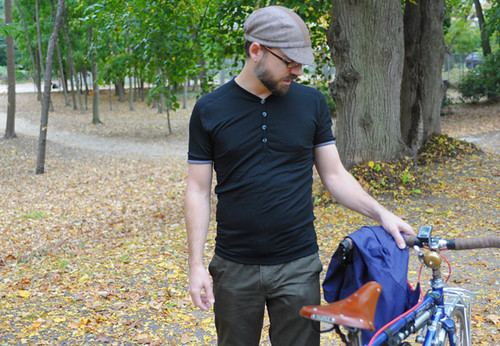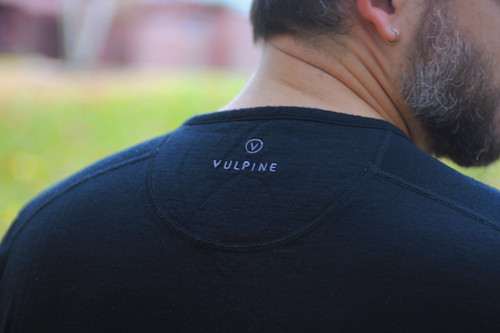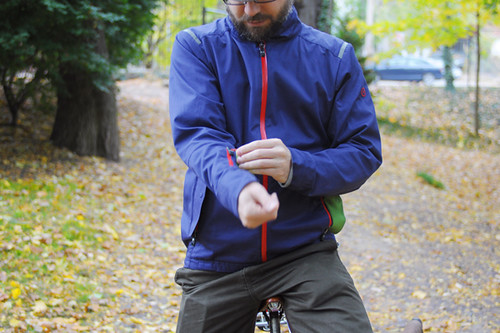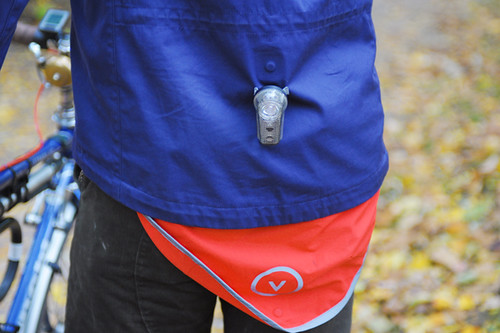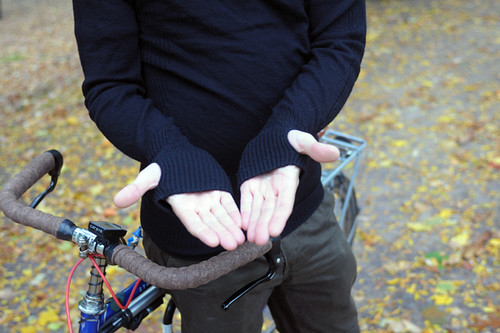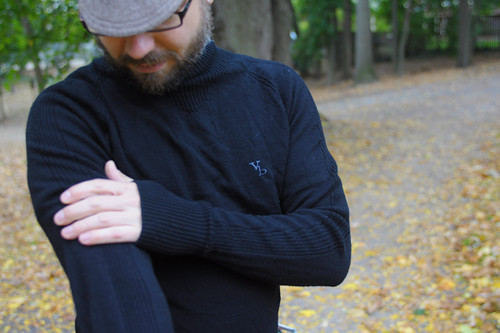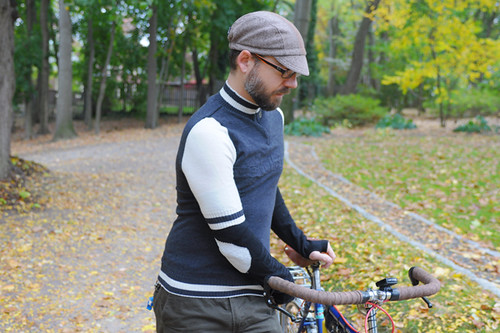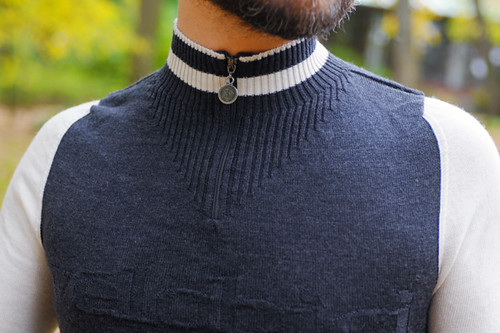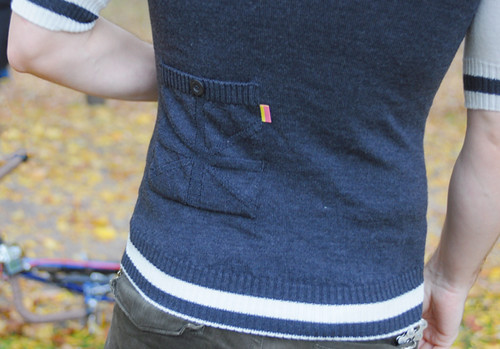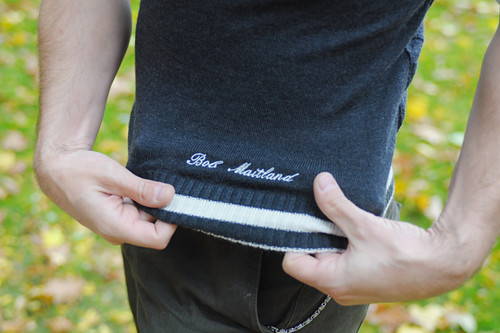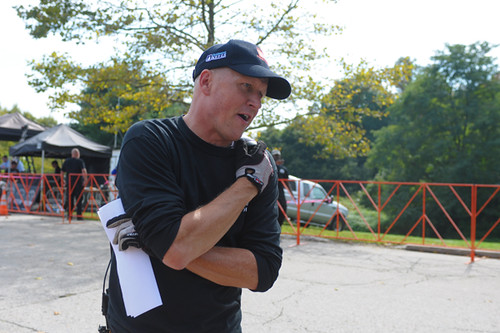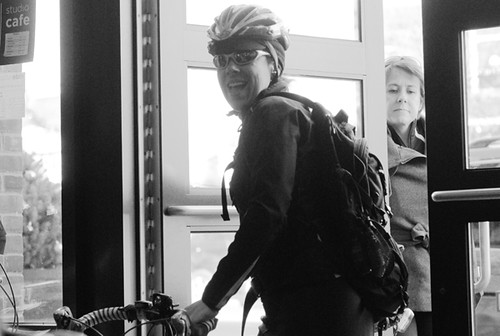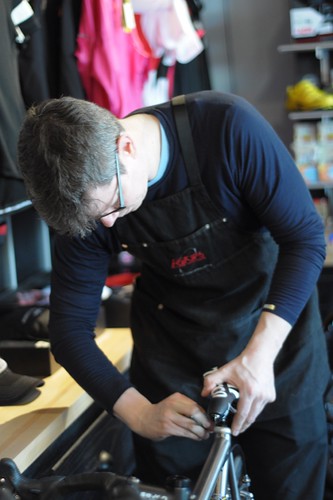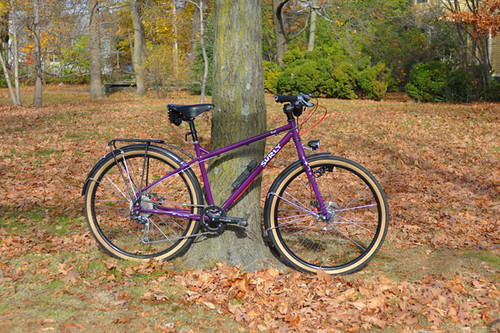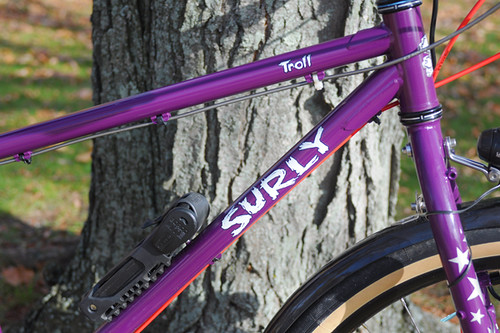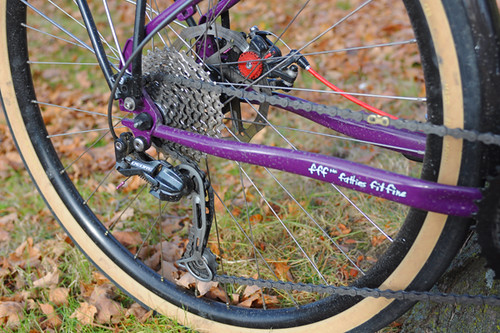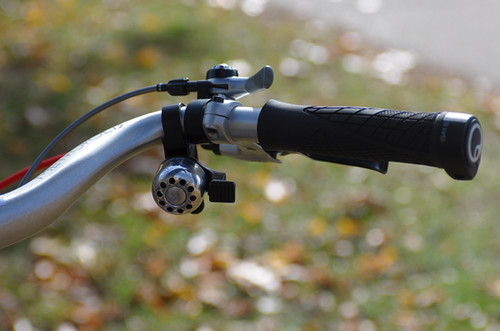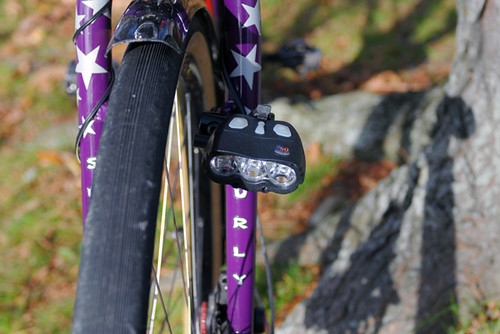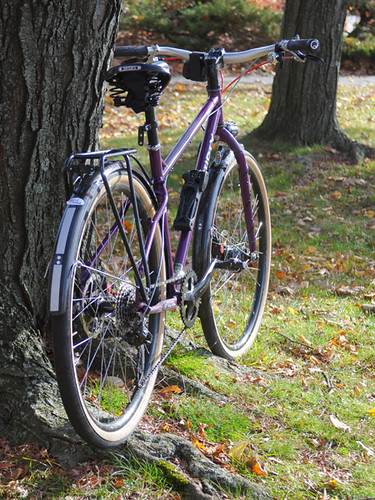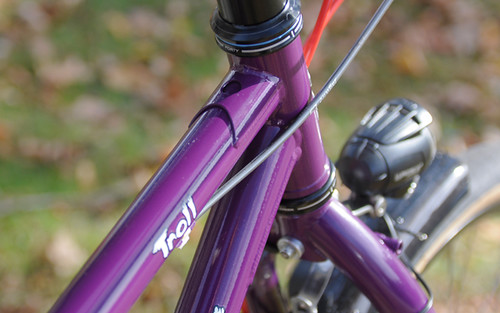
Vulpine is a Surrey-based company that launched in March 2012, with the goal of designing garments that "perform a technical task for cycling and life." These garments utilise mostly natural fabrics and are available in subdued, classic colour schemes. The Merino Button Jersey shown here is one of their staple items.
Cut long and slim, this jersey is made from 180 gram Tasmanian merino wool, manufactured in China. Shown here in black, it is also available in blue. The overall look is subtle, with minimal branding.
The neckline of the jersey is V-shaped, similar to the neckline of an American baseball jersey. Four small buttons (engraved and featuring V-stitching) take the place of a zipper.
A silicone waist gripper holds the hem in place. There are two side pockets and one middle zippered pocket in the rear. Above the middle picket is a reflective strip and a tail light tab.
The sleeves are edged with gray trim. An encircled V is subtly embroidered in gray here and elsewhere on the jersey.
Model's feedback: VC has been wearing the Vulpine merino jersey for a couple of months for commuting now. He also wore it on the Vermont Fall Classic brevet earlier this season. The men's jersey fits his slender masculine build very nicely. The fabric feels comfortable and light to him. He finds the temperature regulation and moisture wicking properties excellent. The weight of the fabric makes it best suitable as a warm weather jersey, or a layering piece. The design of the jersey suits VC's riding style as well as his personal style. He is happy to continue wearing it for commuting and recreational rides.
My feedback: I wore this jersey once. I liked the soft, feather-light fabric, and felt that the amount of stretch was just right. While the cut of the men's jersey was a bit too long and narrow in the hips for me, there is now a women's version that should work fine. However, the style in general is not really for me: It is too sporty to blend in with my everyday attire, but not sporty enough to work as a roadcycling jersey for my needs. As far as commuting and casual riding, Vulpine's new long sleeve polo might be more up my alley. And as far as roadcycling, I hope they consider manufacturing a more traditional cycling jersey using the same great fabric.
The Vulpine Cotton Rain Jacket is one of the more unique pieces of outerwear I have seen. The aesthetic is at once minimal and eye-catching. The structured look is extremely flattering on a man's body: subtly broadening the shoulders while elongating and slimming the torso. Vulpine's description as "influenced by British and military tailoring" is spot on. The unexpected colourschemes (available in charcoal and indigo, with bits of neon green and red peeking out) add a modern, urban twist.
The Vulpine Rain Jacket is handmade (in South Korea) from "microscopically treated Epic Cotton™- a fabric created by applying a microscopic silicon coating to cotton before weaving." The fabric is advertised as wind, water and stain resistant.
The jacket's features include exterior side pockets and sleeve pocket with zip and magnetic closures, magnetic closures at the collar, rear vents, waterproof reflective zippers and sleeve cuffs, roomy interior pockets, drawcords at the hem, waist and neck.
The rear features a magnetic pull-down splash guard with reflective features, and a tail light loop.
Model's feedback: VC has been wearing the Vulpine Cotton Rain Jacket for a couple of months now for commuting. He also wore it on the Vermont Fall Classic brevet - which included many miles of heavy rain. So far, he has found the jacket to be entirely waterproof and wind resistant. It fits him well and allows for easy movement on the bike. The sleeves are sufficiently long and do not pull. He finds the multitude of pockets and features useful. One critical piece of feedback, is that the pull-down flap in the rear does not always stay up when he wants it stowed away. Perhaps there is a way to address this in the garment's next iteration.
My feedback: As of now, there is no women's version of this jacket, and the men's does not fit my body well (too big in the shoulders and too long in the torso). I was therefore unable to form a personal impression of this garment. It looks great on VC.
Overall impressions of Vulpine apparel: If you prefer natural fabrics, classic design and are looking for a style that combines cycling clothes and casual wear, they are worth looking into. Mostly menswear for now, but a women's line is forthcoming.
The Leicester-based Velobici was launched in 2011, manufacturing UK-made apparel "for riding, socialising or working." Their signature Seamless Knitwear line features classically cut merino wool tops and accessories. The San Remo Classic Turtleneck is a lightweight long-sleeve pullover cut slender and long. The garment pictured on the model is actually one that I've been wearing myself, but I asked VC to model it for the camera because the fit works so much better on his body than on mine. More on this topic later.
The distinguishing feature of the San Remo is that it's literally knitted as one piece. There is not a single seam on the entire garment, yet cleverly placed darts shape the garment and add interesting textures.
Velobici does not provide information about the weight of the wool, but it is versatile enough to be worn on its own or over a base layer.
The sleeves are quite long, with generously sized thumb loops.
The knit is reinforced at the long hem, for increased durability.
Model's feedback: VC wore the pullover in the course of the photo-shoot. He liked the texture and feel of the San Remo and found that it fit him well, including the thumb loops.
My feedback: I have worn the San Remo through all of last Spring and this Fall. I have found it most useful for long distance rides on an upright bike. I have never owned another "normal looking" wool sweater that works quite this well at regulating my body temperature. On my unseasonably cold trip to Ireland last May, I ended up wearing the San Remo nearly every day for 3 weeks straight, while cycling for 20-50 miles a day, simply because nothing else worked as well. When the pullover gets wet in the rain, it dries surprisingly quickly. It does not require much washing. And it has suffered hardly any pilling despite heavy use. The seamless construction eliminates chafing. The extra long hem at the rear provides full coverage even with low-rise trousers, whereas my other sweaters tend to ride up. The sleeves are long enough to use the thumb-loops. This sweater is in fact perfect, with my only complaint being that it is designed for men and looks awkward on me. Namely, my upper arms are not big enough to fill out the sleeves up top, and when I wear this sweater it looks like I have bat wings. It is also a bit too long in the torso. I strongly encourage Velobici to design a women's version of the San Remo. Functuonality-wise, this is the best sweater I have ever owned, and so I bought it from them for personal use despite the ill fit.
The Velobici Bob Maitland jersey, named after a 1948 Olimpic road cyclist, is a short sleeve two-tone jersey made from organic South African merino wool. It is seamless in construction. Sshown here with a pair of arm warmers.
The jersey features a 3/4 zip with a fairly high collar.
The tone-on-tone branding across the chest is subtle and textural. The zipper-pull is engraved with the Velobici logo.
The sleeves are quite long, extending neatly to the elbows.
The single rear button pocket is knitted with a textural, tone-on-tone Union Jack pattern. The hem is subtly elongated in the rear.
Bob Maitland's name is embroiderd in cream in the front.
Model's feedback: VC found the Bob Maitland jersey soft, comfortable, warm and itch-free. Aesthetically, he finds it quite attractive. The size XS fit him snugly, but works both as a base layer and as a mid layer. In the summer, this jersey might be too warm to wear, he feels, but it works perfectly in the early Fall New England temperatures on its own, or layered later in the season. About the rear pocket, he reports: "It is basically unreachable and appears to be mostly decorative. My hand just can't practically reach that pocket, it's too high." However, for his style of riding, jersey pockets are not an especially important feature. This jersey suits his personal style and he is happy to continue wearing it for commuting and recreational rides.
My feedback: I wore the Bob Maitland jersey once. As with my pullover, I was impressed with the comfort of the seamless construction. It is attractive and the feel is luxurious. However, I felt that the fabric was too warm for a short sleeve jersey (I was not able to wear it in temperatures above 70°F). Long sleeves might have made more sense here.
Overall impressions of Velobici: The seamless construction of the merino knitwear line is impressive and might spoil you from traditionally constructed garments. The softness of the merino wool is almost cashmere-quality, and seems best suited for colder temperatures. While these garments are designed for casual more than performance cycling, there is now also a roadie line. The women's line is sparse and focuses on urban fashions.
Both Velobici and Vulpine seem focused on high quality, on classic looks, and on hybrid designs to accommodate both roadcycling and commuting. I am on board with all of this in theory, but remain skeptical that the last bit can be accomplished. I think that these brands have a future. But I predict their offerings will polarise into more performance-specific and commuter-specific lines over time - both of which could be interesting and useful.

